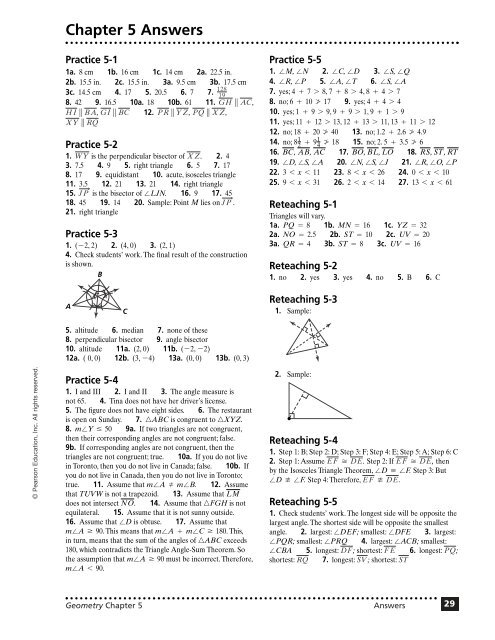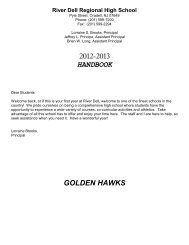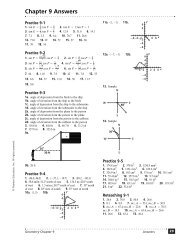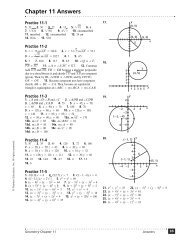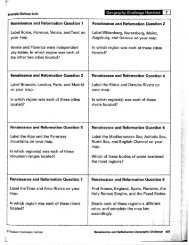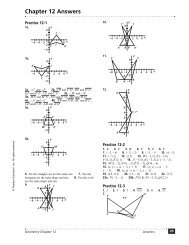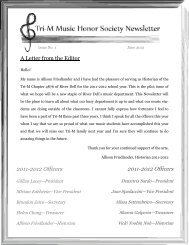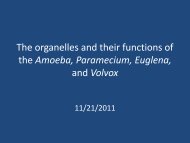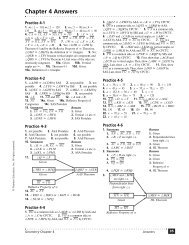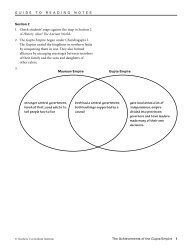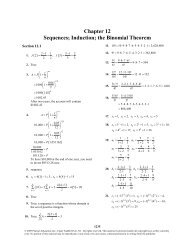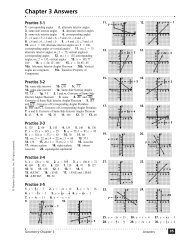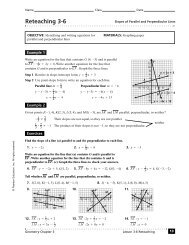Chapter 5 Answers (continued)
Chapter 5 Answers (continued)
Chapter 5 Answers (continued)
You also want an ePaper? Increase the reach of your titles
YUMPU automatically turns print PDFs into web optimized ePapers that Google loves.
<strong>Chapter</strong> 5 <strong>Answers</strong><br />
Practice 5-1<br />
1a. 8 cm 1b. 16 cm 1c. 14 cm 2a. 22.5 in.<br />
2b. 15.5 in. 2c. 15.5 in. 3a. 9.5 cm 3b. 17.5 cm<br />
128<br />
3c. 14.5 cm 4. 17 5. 20.5 6. 7 7.<br />
19<br />
8. 42 9. 16.5 10a. 18 10b. 61 11. GH 6 AC,<br />
HI 6 BA, GI 6 BC 12. PR 6 YZ, PQ 6 XZ,<br />
XY 6 RQ<br />
Practice 5-2<br />
1. WY is the perpendicular bisector of XZ. 2. 4<br />
3. 7.5 4. 9 5. right triangle 6. 5 7. 17<br />
8. 17 9. equidistant 10. acute, isosceles triangle<br />
11. 3.5 ) 12. 21 13. 21 14. right triangle<br />
15. JP is the bisector of LJN. 16. 9 17. 45<br />
)<br />
18. 45 19. 14 20. Sample: Point M lies on JP .<br />
21. right triangle<br />
Practice 5-3<br />
1. (-2, 2) 2. (4, 0) 3. (2, 1)<br />
4. Check students’ work. The final result of the construction<br />
is shown.<br />
B<br />
Practice 5-5<br />
1. M, N 2. C, D 3. S, Q<br />
4. R, P 5. A, T 6. S, A<br />
7. yes; 4 + 7 8, 7 + 8 4, 8 + 4 7<br />
8. no; 6 + 10 17 9. yes; 4 + 4 4<br />
10. yes; 1 + 9 9, 9 + 9 1, 9 + 1 9<br />
11. yes; 11 + 12 13, 12 + 13 11, 13 + 11 12<br />
12. no; 18 + 20 40 13. no; 1.2 + 2.6 4.9<br />
1 1<br />
14. no; 82<br />
+ 94<br />
18 15. no; 2. 5 + 3.5 6<br />
16. BC, AB, AC 17. BO, BL, LO 18. RS, ST,<br />
RT<br />
19. D, S, A 20. N, S, J 21. R, O, P<br />
22. 3 x 11 23. 8 x 26 24. 0 x 10<br />
25. 9 x 31 26. 2 x 14 27. 13 x 61<br />
Reteaching 5-1<br />
Triangles will vary.<br />
1a. PQ = 8 1b. MN = 16 1c. YZ = 32<br />
2a. NO = 2.5 2b. ST = 10 2c. UV = 20<br />
3a. QR = 4 3b. ST = 8 3c. UV = 16<br />
Reteaching 5-2<br />
1. no 2. yes 3. yes 4. no 5. B 6. C<br />
A<br />
C<br />
Reteaching 5-3<br />
1. Sample:<br />
© Pearson Education, Inc. All rights reserved.<br />
5. altitude 6. median 7. none of these<br />
8. perpendicular bisector 9. angle bisector<br />
10. altitude 11a. (2, 0) 11b. (-2, -2)<br />
12a. ( 0, 0) 12b. (3, -4) 13a. (0, 0) 13b. (0, 3)<br />
Practice 5-4<br />
1. I and III 2. I and II 3. The angle measure is<br />
not 65. 4. Tina does not have her driver’s license.<br />
5. The figure does not have eight sides. 6. The restaurant<br />
is open on Sunday. 7. ABC is congruent to XYZ.<br />
8. mY 50 9a. If two triangles are not congruent,<br />
then their corresponding angles are not congruent; false.<br />
9b. If corresponding angles are not congruent, then the<br />
triangles are not congruent; true. 10a. If you do not live<br />
in Toronto, then you do not live in Canada; false. 10b. If<br />
you do not live in Canada, then you do not live in Toronto;<br />
true. 11. Assume that mA 2 mB. 12. Assume<br />
that TUVW is not a trapezoid. 13. Assume that LM<br />
does not intersect NO. 14. Assume that FGH is not<br />
equilateral. 15. Assume that it is not sunny outside.<br />
16. Assume that D is obtuse. 17. Assume that<br />
mA 90. This means that mA + mC 180. This,<br />
in turn, means that the sum of the angles of ABC exceeds<br />
180, which contradicts the Triangle Angle-Sum Theorem. So<br />
the assumption that mA 90 must be incorrect. Therefore,<br />
mA 90.<br />
2. Sample:<br />
Reteaching 5-4<br />
1. Step 1: B; Step 2: D; Step 3: F; Step 4: E; Step 5: A; Step 6: C<br />
2. Step 1: Assume EF DE. Step 2: If EF DE, then<br />
by the Isosceles Triangle Theorem, D F. Step 3: But<br />
D F. Step 4: Therefore, EF DE.<br />
Reteaching 5-5<br />
1. Check students’ work. The longest side will be opposite the<br />
largest angle. The shortest side will be opposite the smallest<br />
angle. 2. largest: DEF; smallest: DFE 3. largest:<br />
PQR; smallest: PRQ 4. largest: ACB; smallest:<br />
CBA 5. longest: DF; shortest: FE 6. longest: PQ;<br />
shortest: RQ 7. longest: SV; shortest: ST<br />
Geometry <strong>Chapter</strong> 5 <strong>Answers</strong> 29
<strong>Chapter</strong> 5 <strong>Answers</strong> (<strong>continued</strong>)<br />
Enrichment 5-1<br />
1., 5. y<br />
A<br />
4 F<br />
D<br />
2<br />
B 2E<br />
4 C 6<br />
2<br />
x<br />
3. centroid 4. interior 5. It is not possible for the<br />
centroid to be on the exterior because all the medians are in<br />
the interior of the triangle.<br />
6. E<br />
F<br />
H<br />
2. D(0, 3) 3. E(2.5, 0) 4. F(2.5, 3)<br />
6. 3.75 square units 7. They are equal. 8. 1 : 4<br />
9., 13. y Q<br />
4<br />
2<br />
2<br />
4<br />
V<br />
T<br />
2 4 6<br />
10. T(3.5, 0.5) 11. U(9, -3) 12. V(6.5, 0.5)<br />
14. 21 square units 15. 5.25 square units<br />
Enrichment 5-2<br />
1.–10. Check students’ work.<br />
8 10 12x<br />
R U S<br />
7. orthocenter 8. It is possible for the orthocenter<br />
to be in the interior, the exterior, or on the triangle itself.<br />
Explanations may vary.<br />
9.<br />
I<br />
X<br />
Center<br />
of Gravity<br />
Y<br />
Z<br />
11. Check students’ work. Give hint: mAOB = 45°.<br />
A<br />
O<br />
B<br />
Enrichment 5-3<br />
1.–2.<br />
A<br />
10. Check students’ work. 11. centroid<br />
Enrichment 5-4<br />
1. If a fish is a salmon, then it swims upstream. 2. If a fish<br />
swims upstream, then it is a salmon. 3. If a fish is not a<br />
salmon, then it does not swim upstream. 4. If a fish does<br />
not swim upstream, then it is not a salmon. 5. Exercises 1<br />
and 4 6. the salmon 7. the fish that swim upstream<br />
8.<br />
U<br />
9.<br />
U<br />
Q<br />
Q<br />
P<br />
10. 11.<br />
U<br />
Q<br />
P<br />
Q<br />
U<br />
© Pearson Education, Inc. All rights reserved.<br />
P<br />
P<br />
D<br />
B<br />
C<br />
30<br />
<strong>Answers</strong> Geometry <strong>Chapter</strong> 5
<strong>Chapter</strong> 5 <strong>Answers</strong> (<strong>continued</strong>)<br />
© Pearson Education, Inc. All rights reserved.<br />
12. If a quadrilateral is a rectangle, then the angles of the<br />
quadrilateral are congruent. 13. If the angles of a<br />
quadrilateral are not congruent, then the quadrilateral is<br />
not a rectangle. 14. If a quadrilateral is not a rectangle,<br />
then the angles of the quadrilateral are not congruent.<br />
15. All are true (12, 13, and 14). 16. the contrapositive<br />
Enrichment 5-5<br />
1. U 2. T 3. F 4. T 5. U 6. F 7. T<br />
8. T 9. T 10. F 11. T 12. U 13. T<br />
14. F 15. F 16. U 17. T 18. T<br />
The name of the mathematician is THALES (th – a l – ez).<br />
<strong>Chapter</strong> Project<br />
Activity 1: Creating<br />
isoceles; median, angle bisector, perpendicular bisector<br />
Activity 2: Experimenting<br />
Check students’ work.<br />
Activity 3: Designing<br />
Check students’ work.<br />
✔ Checkpoint Quiz 1<br />
1. angle ) bisector, since TM NM 2. congruent, since<br />
QM is the angle bisector 3. 20, since TM NM<br />
4. 6 5. 4 6a. 18 6b. 42 7. altitude<br />
8. congruent<br />
✔ Checkpoint Quiz 2<br />
1. Inv: If you don’t eat bananas, then you will not be healthy.<br />
Contra.: If you are not healthy, then you don’t eat bananas.<br />
2. Inv.: If a figure is not a triangle, then it does not have three<br />
sides. Contra.: If a figure does not have three sides, then it is<br />
not a triangle. 3. Suppose that there are two obtuse angles<br />
in a triangle. This would mean that the sum of two angles of a<br />
triangle would exceed 180°. This contradicts the Triangle-Sum<br />
Theorem. Therefore, there can be only one obtuse angle in a<br />
triangle. 4. Suppose that the temperature is below 32°F<br />
and it is raining. Because 32°F is the freezing point of water,<br />
any precipitation will be in the form of sleet, snow, or freezing<br />
rain. This contradicts the original statement. Therefore,<br />
the temperature must be above 32°F for it to rain.<br />
5. yes; 6 + 4 8, 8 + 6 4 6. no; 2.6 + 4.1 6.7<br />
7. B, C, A 8. D, F, E<br />
<strong>Chapter</strong> Test, Form A<br />
1a. If a triangle does not have three congruent sides, then it is<br />
not equiangular; true. 1b. If a triangle is not equiangular,<br />
then it does not have three congruent sides; true. 2a. If<br />
an isosceles triangle is not obtuse, then the vertex angle is<br />
not obtuse; true. 2b. If the vertex angle of an isosceles<br />
triangle is not obtuse, then the triangle is not obtuse; true.<br />
3a. If two lines are not parallel, then they intersect; false.<br />
3b. If two lines intersect, then they are not parallel; true.<br />
4. x = 9.5 5. x = 5 6. Sample: EF HG<br />
7. I and III 8. II and III 9. D, B, C<br />
10. B, D, C 11. C, D, B 12. C<br />
13. Sample: Assume that an equilateral triangle has a right<br />
angle. This means that one angle measures 90. This, in turn,<br />
means that each of the three angles is 90 because the triangle<br />
is equilateral and also equiangular. This means that the angle<br />
sum of the triangle is 270, contradicting the Triangle Angle-<br />
Sum Theorem. So the assumption that an equilateral triangle<br />
can have a right angle must be incorrect. Therefore,<br />
an equilateral triangle cannot have a right angle.<br />
14. Each leg must be greater than 5 units in length.<br />
15. 6; 30 16. on 17. inside 18. outside<br />
19. AB 20. XD, XC, XB 21. (5, 4)<br />
22. (1, -2) 23. 2 24. 15 25. 24<br />
<strong>Chapter</strong> Test, Form B<br />
1a. If mA 2 30, then A is not acute; false<br />
1b. If A is not acute, then mA 2 30; true 2a. If the<br />
compact disc costs $13 or more, then Jose will not buy it; false.<br />
2b. If Jose does not buy the compact disc, then it must cost<br />
$13 or more; true. 3a. If two angles of a triangle are not<br />
complementary, then the third angle is not a right angle; true.<br />
3b. If the third angle of a triangle is not a right angle, then the<br />
other two angles are not complementary; true. 4. x = 22<br />
5. x = 3 6. Sample: VW UX 7. II and III<br />
8. I and III 9. B, D, C 10. B, C, D<br />
11. D, C, B 12. A 13. Sample: Assume that<br />
a triangle has two right angles. The sum of these two angles<br />
then must be 180. When the third angle is added to the total,<br />
the angle sum of the triangle would be greater than 180,<br />
contradicting the Triangle Angle-Sum Theorem. Therefore, a<br />
triangle can have at most one right angle. 14. Each leg<br />
must be greater than 8.5 units in length. 15. 9; 37<br />
16. outside 17. inside 18. on 19. BC<br />
20. 3, 1, 2 21. (5, 5) 22. (-7, 2) 23. 15<br />
24. 30 25. 12<br />
Alternative Assessment, Form C<br />
TASK 1: Scoring Guide<br />
Sample: Assume that Harold can create a triangular garden<br />
plot with sides of 6 ft, 6 ft, and 13 ft. Then a triangle is possible<br />
with sides 6, 6, and 13. But 6 + 6 13, so by the Triangle<br />
Inequality Theorem, no such triangle exists. Therefore, the<br />
plan is impossible.<br />
3 Student gives a clear and accurate explanation.<br />
2 Student gives an explanation that contains minor<br />
inaccuracies.<br />
1 Student gives an explanation that contains significant<br />
flaws in logical reasoning.<br />
0 Student makes little or no attempt.<br />
Geometry <strong>Chapter</strong> 5 <strong>Answers</strong> 31
<strong>Chapter</strong> 5 <strong>Answers</strong> (<strong>continued</strong>)<br />
TASK 2: Scoring Guide<br />
Sample: The locus of points in a plane equidistant from a<br />
single point forms a circle, as shown in the first figure. The<br />
locus of points in a plane equidistant from the endpoints<br />
of a segment forms a perpendicular bisector of the segment,<br />
as shown in the second figure.<br />
ADC is isosceles. BAC = BCA because ABC<br />
is an isosceles triangle with AB = BC. The angle bisectors<br />
create two new angles at each vertex of ABC, each of<br />
1<br />
which has a measure 2 that of the angle bisected. Thus<br />
mDAC = 1 mBAC and mDCA = 1 mBCA.<br />
2<br />
2<br />
Because mBAC = mBCA, mDAC = mDCA,<br />
which makes ADC an isosceles triangle.<br />
3 Student gives accurate answers and justification.<br />
2 Student gives answers containing minor errors.<br />
1 Student gives a justification containing major logical gaps.<br />
0 Student makes little or no effort.<br />
3 Student gives an accurate explanation and drawings.<br />
2 Student gives a drawing or an explanation that contains<br />
minor errors.<br />
1 Student gives an explanation or a drawing that contains<br />
significant errors.<br />
0 Student makes little or no attempt.<br />
TASK 3: Scoring Guide<br />
Expressed as a conditional: If ABC is an equilateral triangle<br />
with midpoints D, E, and F on sides AB, BC, and AC<br />
respectively, then DEF forms an equilateral triangle.<br />
Sample: DEF is an equilateral triangle. Each of DEF ’s<br />
1<br />
sides is exactly 2 the corresponding side of ABC. If ABC’s<br />
sides are all the same length, then all of DEF ’s sides are all<br />
the same length as well.<br />
Cumulative Review<br />
1. A 2. B 3. D 4. C 5. B 6. B 7. D<br />
8. C 9. D 10. A 11. A 12. D 13. B<br />
14. A 15. 24 16. 28 17. Sample: The principal is<br />
giving a student an award. 18. Suppose that an equilateral<br />
triangle has an obtuse angle. Then one angle in the triangle<br />
has a measure greater than 90. But this contradicts the fact<br />
that in an equilateral triangle, the measure of each angle is 60.<br />
Therefore, the equilateral triangle does not have an obtuse<br />
angle.<br />
19. Sample:<br />
6 8<br />
10<br />
8<br />
4 4<br />
8<br />
3 Student accurately states the conditional and the proof.<br />
2 Student has minor errors in the statement of the conditional<br />
or in the proof.<br />
1 Student gives a statement of conditional or a proof that<br />
contains significant errors.<br />
0 Student makes little or no attempt.<br />
TASK 4: Scoring Guide<br />
Sample:<br />
A<br />
B<br />
D<br />
C<br />
20. (-1, 2)<br />
21.<br />
Q<br />
22. C, B, A<br />
T<br />
M<br />
© Pearson Education, Inc. All rights reserved.<br />
32<br />
<strong>Answers</strong> Geometry <strong>Chapter</strong> 5


